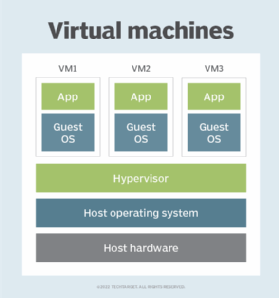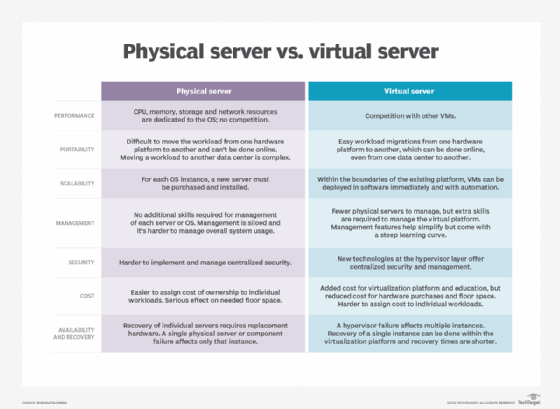virtual server
What is a virtual server?
A virtual server, also known as a virtual machine (VM), is a partitioned space inside a real server and is transparent to users, replicating the functionality of a dedicated physical server. Typically housed in the cloud or another off-site data center, a virtual server uses hardware and resources that are shared by several other users with varying levels of control.
Virtual servers make it easy to reallocate resources and adapt to dynamic workloads.
How does a virtual server work?
A virtualization software called a hypervisor partitions the physical server or the host machine into several VMs, with each running its own operating system (OS). The hypervisor's abstraction or isolation of the underlying host machine hardware enables the multiple VMs to effectively share the physical server's compute resources, such as network bandwidth and memory space.
In essence, the hypervisor functions as the host's OS by running on top of the server's hardware and giving VMs the isolation they need to function independently.
There are three essential types of virtualizations:

- Full virtualization. This virtualization occurs when the hypervisor controls all communication between the central processing unit (CPU) and the physical server. The hypervisor's primary duties include controlling the physical server's capacity and routing traffic to virtual servers to run particular applications.
- Paravirtualization. Through paravirtualization, the entire network of servers -- both physical and virtual -- is connected to act as one coherent unit. This form of virtualization only makes minimal use of the hypervisor's processing capability to manage OSes.
- OS-level virtualization. A hypervisor is not necessary for OS-level virtualization because the host OS manages capacity on its own. However, the only prerequisite for this kind of virtualization is that all of the virtual servers on the host must run the same OS.
A great example of server virtualization in action is a company that requires many server tasks, such as a web server for web hosting, a domain controller for internal user authentication, and a database server for storing and maintaining databases. The business can use server virtualization to create a number of virtual servers and consolidate all of these server tasks onto a single physical server rather than establishing numerous physical servers.
Benefits of a virtual server
Virtual servers provide various use cases and benefits for organizations from cost savings to instant scalability. Popular advantages of virtual servers include the following:
- Cost-effective. Virtual private servers are significantly more cost-effective than physical servers since they operate on shared hardware and resources and split running expenses with other users. They also require less power and less floor space as only one physical server is used for multiple virtual servers. Therefore, virtual servers are a great option for organizations on a limited budget that are looking for instant scalability.
- Increased usable capacity. Server virtualization increases usable capacity, as it's no longer constrained by the resources of a single server. Without virtualization, processing power is dramatically reduced since workloads are only distributed across a small section of each network server. As a result, servers are not completely utilized, wasting resources.
- Green technology. Organizations that promote green technology might opt for virtual servers. Virtualization enables one physical server to accommodate multiple virtual servers, which use less energy compared to having multiple dedicated servers. This not only saves money in the long run, but is also beneficial for the environment.
- Instant provisioning. A dedicated bare-metal server generally requires more time to provision than a virtual server. For example, if a data center provider does not have hardware in stock, ordering and setting up the components can take some time. With server virtualization, systems may be provisioned and deployed in a matter of minutes, enabling organizations to clone an existing VM without having to spend the time and money necessary to buy and set up a new physical server.
- Efficient DevOps. When using virtual servers, maintenance activities have little to no effect on the production environment, and in most cases, no downtime is required. Additionally, virtual servers make it possible to streamline the testing and development processes. The separate user environments guarantee that activities such as software testing don't have an impact on all users sharing the same physical server host.
- Improved productivity. Due to faster server provisioning of virtual servers, organizations can experience overall improvements and automations in IT productivity. New servers can be spun up and deployed quickly without requiring a lot of time, and when a server is no longer needed, it can easily be decommissioned.
- Easier disaster recovery (DR). Virtualization can simplify recovery procedures and reduce the quantity of hardware needed at a DR site. Servers that are virtualized are isolated from the underlying hardware as they're containerized into VMs, and the primary and the secondary DR site do not require the same physical servers. They also enable frequent replication of critical systems and can, therefore, easily spin up new instances or fail over to a backup option when disaster strikes.
Disadvantages of a virtual server
Although virtual servers offer numerous advantages, they also have some drawbacks. The most frequent issues with virtual servers include the following:
- Security vulnerabilities. In virtual environments, the security of the virtual servers is dependent on the hypervisor and may be invisible to traditional security measures. Therefore, the risk of malware injections and open attack vectors increases since the hypervisor has control over the VMs and their access to computational resources.
- Single point of failure. If a physical server goes offline, all the VMs on its hypervisor will also go offline. For example, if multiple websites are hosted on a server, all of them will go down if the server disconnects or reboots. To resolve this issue, businesses could set up a cluster of servers.
- Virtualization sprawl. Administrators are prone to create more VMs than necessary since virtual servers are comparatively simple to build. Virtualization sprawl results when businesses are forced to maintain more virtual servers than they can handle.
- Resource hogging. The most frequent issue with server virtualization is resource wasting. A physical server can sometimes become overcrowded with too many virtual servers and function poorly.
Physical server vs. virtual server
A virtual server is an abstraction of a physical server, whereas a physical server is a piece of hardware with recognizable components, including a CPU, memory and a motherboard. A physical server can run any type of OS, such as Windows or Linux, but it can only run one OS in one instance.
The following are some differences between physical and virtual servers:
- Cost. Physical servers are more expensive as physical hardware comes with a higher price tag and requires the buying of additional hardware for upgrades and maintenance. Although, the initial cost of the software is lower in a physical server, it ultimately costs far more to scale and upgrade. On the other hand, a virtual server normally has a greater upfront cost due to higher software licensing costs of VMs, but its scaling and maintenance expenses are relatively reasonable.
- Performance. A physical server often performs better than a virtual server due to its dedicated resources. A virtual server's shared resources can occasionally result in performance degradation and optimization issues.
- Space. Because numerous virtual servers can be placed on a single physical server, virtual servers are more space-efficient than physical servers and require a smaller physical footprint.
- Implementation. The implementation and migration of physical servers can be challenging since they're done manually. Virtual servers, on the other hand, can be set up, run and moved across the environment with ease.
- Security. Since security is customized for each server, physical servers are more secure than virtual servers. Because the security of virtual servers is centralized for simpler management, they are more open to security intrusions.
- Scalability. Virtual servers can scale on demand, whereas physical servers are difficult to scale and require the purchase and installation of additional hardware.
- Availability and recovery. Because physical servers exist on-site, there's a higher risk to business continuity during power outages and natural disasters. However, on virtual servers, physical failures can be isolated from the OS or application, reducing the likelihood of downtime.
- Management. Physical servers can be managed without the need for additional expertise. However, they are often more difficult to administer due to siloed management, which makes it difficult to control the overall system usage. Virtual servers are simpler to manage since there are fewer physical servers involved and because virtual servers have great management options. The only downside is that the management of virtual servers requires specialized skills and a steep learning curve.

What is a virtual desktop?
A virtual desktop is a pre-configured image of OSes and applications in which the desktop environment is separated from the physical device used to access it. Users can connect to virtual desktops remotely or through a network. The desktop virtualization system known as virtual desktop infrastructure, or VDI, distributes virtual desktops to endpoint devices from an on-site or cloud-based data center, and users access the virtual desktop using peripherals, such as a mouse, keyboard and touchscreen.
For the end user, a virtual desktop feels similar to using a physical workstation. The user experience is far better as most of the resources, including storage and back-end databases, are readily available. However, depending on how it's set up, the majority of users cannot permanently install programs or store changes.
The OSes and computational power of virtual desktops are typically operated on VMs hosted by hypervisors rather than on physical machines, even though a virtual desktop and a VM are fully distinct from one another.
Since the early 2000s, server virtualization has advanced significantly and offers unparalleled advantages. Find out what the top 10 advantages of server virtualization are for enterprises.







